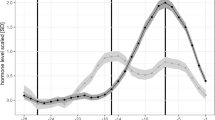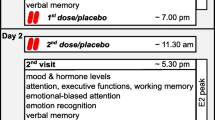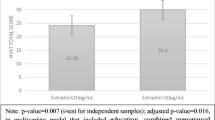Abstract
The present study examined differences in Stroop and memory task performances modulated by gonadal steroid hormones during the menstrual cycle in women. Thirty women with regular menstrual cycles performed a logical memory task (Wechsler Memory Scale) and the Stroop task. The results showed a significant difference in Stroop task performance between low and high levels of estradiol and progesterone during the menstrual cycle, but there was no significant difference in memory performance between the two phases, nor was there any significant mood change that might have influenced cognitive performance. These findings suggest that sex-related hormone modulation selectively affects cognitive functions depending on the type of task and low level secretion of estradiol appears to contribute to reducing the level of attention that relates to the prefrontal cortex.
Similar content being viewed by others
References
Alexander, G. M., Altemus, M., Peterson, B. S., & Wexler, B. E. (2002). Replication of a premenstrual decrease in right-ear advantage on language-related dichotic listening tests of cerebral laterality. Neuropsychologia, 40, 1293–1299.
Baddeley, A. (2000). The episodic buffer: A new component of working memory. Trends in Cognitive Sciences, 4, 417–423.
Banich, M. T. (1997). Neuropsychology. Boston: Houghton Mifflin.
Bench, C. J., Frith, C. D., Grasby, P. M., Friston, K. J., Paulesu, E., Frackowiak, R. S., et al. (1993). Investigation of the functional anatomy of attention using the Stroop test. Neuropsychologia, 31, 907–922.
Bibawi, D., Cherry, B., & Hellige, J. B. (1995). Fluctuations of perceptual asymmetry across time in women and men: Effects related to the menstrual cycle. Neuropsychologia, 33, 131–138.
Boyle, G. J. (2002). Prediction of cognitive learning performance from multivariate state-change scores. Australian Educational and Developmental Psychologist, 3, 17–21.
Casasanto, D. J., Killgore, W. D. S., Maldjian, J. A., Glosser, G., Alsop, D. C., Cooke, A. M., et al. (2002). Neural correlates of successful and unsuccessful verbal memory encoding. Brain and Language, 80, 287–295.
Cater, C. S., Mintun, M., & Cohen, J. D. (1995). Interference and facilitation effects during selective attention: An H215O PET study of Stroop task performance. Neuroimage, 2, 264–272.
Cox, T., & Mackey, C. J. (1985). The measurement of self-reported stress and arousal. British Journal of Psychology, 76, 183–186.
Desenbach, N. U. F., Visscher, K. M., Palmer, E. D., Miezin, F. M., Wegner, K., Kang, H., et al. (2006). A core system for the implementation of task sets. Neuron, 50, 799–812.
Erez, A., & Isen, A. H. (2002). The influence of positive affect on the components of expectancy motivation. Journal of Applied Psychology, 87, 1055–1067.
George, J. M., & Zhou, J. (2002). Understanding when bad moods foster creativity and good ones don’t: The role of context and charity of feeling. Journal of Applied Psychology, 87, 687–697.
Hampson, E., Finestone, J. M., & Levy, N. (2005). Menstrual cycle effects on perceptual closure mediated changes in performance on a fragmented objects test of implicit memory. Brain and Cognition, 57, 107–110.
Hao, J., Rapp, P. R., Janssen, W. G. M., Lou, W., Lasley, B. L., Hof, P. R., et al. (2007). Interactive effects of age and estrogen on cognition and pyramidal neurons in monkey prefrontal cortex. Proceedings of the National Academy of Sciences, 104, 11465–11470.
Hatta, T. (1995). Japanese Stress Arousal Checklist: Stress measurement by adjective words. Osaka: Nihon-igaku.
Hatta, T., Hasegawa, Y., & Matsuyama, Y. (2006). Mood changes and higher cognitive function in patients hospitalized for hip fracture and spinal disease. In A. V. Clark (Ed.), Psychology of moods: New research (pp. 161–185). New York: Nova Science Publisher.
Hatta, T., Ito, Y., & Yoshizaki, K. (2001). Digit cancellation test (D-CAT) for attention. Osaka: Union Press.
Hatta, T., Nagahara, N., Iwahara, A., & Ito, E. (2005a). Three-word recall and logical memory recall in normal aging. Journal of Human Environmental Studies, 3, 7–12.
Hatta, T., Nagaya, K., & Onishi, M. (2005b, August). Age related sex difference in higher cognitive abilities in healthy elderly people. Paper presented at the International Behavioral Development Symposium, Minot State University, Minot, ND.
Hatta, T., & Nishiide, S. (1991). Teachers’ stress in Japanese primary schools: Comparison with workers in private companies. Stress and Medicine, 7, 207–211.
Hatta, T., Yoshida, H., Kawakami, A., & Okamoto, M. (2002). Color of computer display frame in work performance, mood, and physiological responses. Perceptual and Motor Skills, 94, 39–46.
Hausmann, M., & Gruturkun, O. (2000). Steroid fluctuations modify functional cerebral asymmetries: The hypothesis of progesterone-mediated interhemispheric decoupling. Neuropsychologia, 38, 1362–1374.
Heister, G., Landis, T., Regard, M., & Schroeder-Heister, P. (1989). Shift of functional cerebral asymmetry during the menstrual cycle. Neuropsychologia, 27, 874–880.
Hirosawa, I., Hatta, T., & Yoneda, K. (1998). Subjective mood variations of student nurses during clinical practice. Stress Medicine, 14, 49–54.
Hollander, A., Hausmann, M., Hamm, J. P., & Corballis, M. C. (2005). Sex hormonal modulation of hemispheric asymmetries in the attentional blink. Journal of the International Neuropsychological Society, 11, 263–272.
Houseman, M., Becker, C., Gather, U., & Gunturkun, O. (2002). Functional cerebral asymmetries during the menstrual cycle: A cross-sectional and longitudinal analysis. Neuropsychologia, 40, 808–816.
Ino, T., Doi, T., Kimura, T., Ito, J., & Fukuyama, H. (2004). Neural substrates of the performance of an auditory verbal memory: Between-subjects analysis by fMRI. Brain Research Bulletin, 64, 115–126.
Johnson, S. C., Saykin, A. J., Flashman, L. A., McAllister, T. W., & Sparling, M. B. (2001). Brain activation on fMRI and verbal memory ability: Functional neuroanatomic correlates of CVLT performance. Journal of International Neuropsychology Society, 7, 55–62.
Kimura, D. (1996). Sex and cognition. Cambridge, MA: MIT Press.
Larisch, R., Meyer, W., Klimke, A., Kehren, F., Vosberg, H., & Muller-Gartner, H. W. (1998). Left-right asymmetry of striatal dopamine D2 receptors. Nuclear Medicine Communications, 19, 781–787.
Lawrence, N. S., Ross, T. J., & Stein, E. A. (2002). Cognitive mechanisms of nicotine on visual attention. Neuron, 36, 539–548.
Leung, H.-C., Skudlarski, P., Gatenby, J. C., Peterson, B. S., & Gore, J. C. (2000). An event-related functional MRI study of the Stroop color word interference task. Cerebral Cortex, 10, 552–560.
Maccoby, E. E. (Ed.). (1966). The development of sex differences. Stanford, CA: Stanford University Press.
MacLeod, C. M. (1991). Half century of research on the Stroop effect: An integrative view. Psychological Bulletin, 109, 163–203.
MacLeod, C. M., & MacDonald, P. A. (2000). Interdimensional interference in the Stroop effect: Uncovering the cognitive and neural anatomy of attention. Trends in Cognitive Sciences, 4, 383–391.
McCourt, M. E., Mark, V. W., Randonovich, K. J., Willson, S. K., & Freeman, P. (1997). The effects of gender, menstrual phase and practice on the perceived location of the midsagittal plane. Neuropsychologia, 35, 717–724.
Mead, L. A., & Hampson, E. (1996). Asymmetric effects of ovarian hormones on hemispheric activity: Evidence from dichotic and tachistoscopic tests. Neuropsychologia, 10, 578–587.
Miles, C., Green, R., Sanders, G., & Hines, M. (1998). Estrogen and memory in a transsexual population. Hormones and Behavior, 34, 199–208.
Peterson, B. S., Kane, M. J., Alexander, G. M., Lacadie, C., Skudlarski, P., Leung, H., et al. (2002). An event-related functional MRI study comparing interference effects in the Simon and Stroop tasks. Cognitive Brain Research, 13, 427–440.
Peterson, B. S., Skudlarski, P., Gatenby, J. C., Zang, H., Anderson, A. W., & Gore, J. C. (1999). An fMRI study of Stroop word-color interference: Evidence for cingulated subregions subserving multiple distributed attention systems. Biological Psychiatry, 45, 1237–1258.
Posner, M. I., & DiGilolamo, G. J. (2000). Attention in cognitive neurosciences: An overview. In M. Gazzaniga (Ed.), The new cognitive neurosciences (2nd ed., pp. 623–632). Cambridge, MA: MIT Press.
Purdon, S. E., Klein, S., & Flor-Henry, P. (2001). Menstrual effects on asymmetrical olfactory acuity. Journal of International Neuropsychological Society, 7, 703–709.
Rode, C., Wagner, M., & Gunturkun, O. (1995). Menstrual cycle affects functional cerebral asymmetries. Neuropsychologia, 33, 855–865.
Schacter, D. L., & Wagner, A. D. (1999). Medial temporal lobe activations in fMRI and PET studies of episodic encoding and retrieval. Hippocampus, 9, 7–24.
Scoville, W. B. (1968). Amnesia after bilateral medial temporal-lobe excision: Introduction to case H. M. Neuropsychologia, 6, 211–213.
Sohlberg, M., & Mateer, C. A. (1989). Introduction to cognitive rehabilitation: Theory and practice. New York: Guilford Press.
Squire, L. R., & Knowlton, B. J. (2002). The medial temporal lobe, the hippocampus, and memory systems of the brain. In M. Gazzaniga (Ed.), The new cognitive neurosciences (2nd ed., pp. 765–780). Cambridge, MA: MIT Press.
Swick, D., & Jovanovic, J. (2002). Anterior cingulate cortex and the Stroop task: Neuropsychological evidence for topographic specificity. Neuropsychologia, 40, 1240–1253.
Taketani, Y., & Maehara, S. (Eds.). (2001). Handbook of midwifery. Tokyo: Igakusyoin.
Acknowledgements
The authors appreciate very much the Editor for his kind and patient help in editing of the article. Part of this study was supported by the grant for science research to the first author from the Ministry of Education, Science, Sports and Culture in Japan (No. 19330158).
Author information
Authors and Affiliations
Corresponding author
Rights and permissions
About this article
Cite this article
Hatta, T., Nagaya, K. Menstrual Cycle Phase Effects on Memory and Stroop Task Performance. Arch Sex Behav 38, 821–827 (2009). https://doi.org/10.1007/s10508-008-9445-7
Received:
Revised:
Accepted:
Published:
Issue Date:
DOI: https://doi.org/10.1007/s10508-008-9445-7




